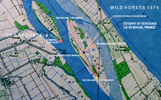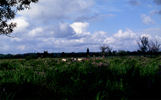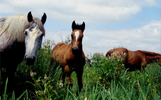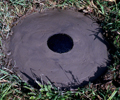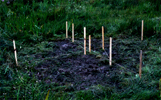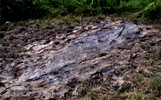In the summer of 1978, I was invited by the Centre de Recherche des Arts Creative Plastiques, in Bordeaux, and The Neue Gallery in Aachen, to create a site specific work on an island in the south of France. "Wild Horses" (1978) is an earthwork measuring 4 miles long x 1 mile wide x 1 meter deep, on the Isle de Macau in the estuary of the Gironde River.
For two weeks I tracked a herd of wild horses, living on the marshy wetlands. Simultaneously I also filmed and documented their behavior in an experimental film of the same name. "Wild Horses" is both metaphoric and plastic. The metaphoric aspect contains two distinct elements.
The first being the boundaries of the island, which I used as a metaphor for the limits of knowledge and the second element was the horses themselves, functioning within these constraints.
On the plastic level, my observations noted four favored grazing areas. These were transposed sculpturally onto the topography by means of four markers: meter-long pipes, sunk vertically, flush with the earth. The first three points were allowed to fill up with rain, creating islands of water. The last point was filled with black concrete. The points were measured and plotted on a topographical map and formed a diamond shape.
The shape was then reduced to human scale using Le Corbusier’s modular system and was situated at the convergence of the x/y axis of the four points. It measured 258.2 cm along its own center.
At this stage, the form was an imaginary ideal, existing only in two dimensions. Depth or the third dimension was created by the incoming tide, which I observed to be one meter. The diamond shape was then dug to that depth, and cement was mixed with the earth that had been excavated. Seawater was added and the mixture was poured back into the form, again flush with the earth.
All colored markers and measuring devices were then removed. Great care was taken not to damage or encumber the beauty and natural order of the plants and animals. The end result exists as a process of creation, and not as a visual presence on the landscape.
